What functional reproduction handguns would be the best for recreating a 18th or 19th century dueling pistol set? Also trying to keep the price down under $1500.00 for this future (next year) project for the pistols. Opinions? Suggestions?
-
This community needs YOUR help today. We rely 100% on Supporting Memberships to fund our efforts. With the ever increasing fees of everything, we need help. We need more Supporting Members, today. Please invest back into this community. I will ship a few decals too in addition to all the account perks you get.

Sign up here: https://www.muzzleloadingforum.com/account/upgrades -
Friends, our 2nd Amendment rights are always under attack and the NRA has been a constant for decades in helping fight that fight.
We have partnered with the NRA to offer you a discount on membership and Muzzleloading Forum gets a small percentage too of each membership, so you are supporting both the NRA and us.
Use this link to sign up please; https://membership.nra.org/recruiters/join/XR045103
You are using an out of date browser. It may not display this or other websites correctly.
You should upgrade or use an alternative browser.
You should upgrade or use an alternative browser.
Dueling Pistol set...
- Thread starter nightwolf1974
- Start date

Help Support Muzzleloading Forum:
This site may earn a commission from merchant affiliate
links, including eBay, Amazon, and others.
- Joined
- Aug 6, 2005
- Messages
- 6,758
- Reaction score
- 4,935
That is going to be VERY hard to achieve. One of the best ways to replicate a flintlock pair is to use two Pedersoli Charles Moore pistols - wherever you can find them, that is. Then you'll need a fitted case and all the accessories - flask, ball mould, turnscrews, mainspring vice and so on.
You MIGHT be able to do for such a small budget, but I wouldn't bet on it.
This post from the past might influence you - Charles Moore Flintlock Target Pistol
You MIGHT be able to do for such a small budget, but I wouldn't bet on it.
This post from the past might influence you - Charles Moore Flintlock Target Pistol
The $1500 is my budget for the pistols alone...the other pieces I can add as I go. This is a long-term project, first I wanna get the pistols. 
- Joined
- Aug 6, 2005
- Messages
- 6,758
- Reaction score
- 4,935

Pedersoli percussion pistol - Charles Moore style - around $750 - for flintlock, add another hundred.
Rather than duelers, think about a cased pair of pistols. Having a cased pair will open up your possibilities to several varieties of rifles pistols.
Dueling pistols were supposed (in England at least, France did not have the defined pattern for pistols) to be smoothbore and no rear sights. They would have had a simple trigger. I know, the Hamilton duelers had a single set trigger that was not disclosed to the seconds or to Aaron Burr.
Dueling pistols were supposed (in England at least, France did not have the defined pattern for pistols) to be smoothbore and no rear sights. They would have had a simple trigger. I know, the Hamilton duelers had a single set trigger that was not disclosed to the seconds or to Aaron Burr.
I actually like the looks of the flint version better....The flintlock seems more the style of my idea,View attachment 40132
Pedersoli percussion pistol - Charles Moore style - around $750 - for flintlock, add another hundred.
At first I was advised to just use a pair of Traditions Kentucky pistols by someone close to me....But that seems kinda cheesy. Then the subject of "inexpensive" military flintlock reproductions came up, (and although I'm doing that for another project) this didn't appeal to me either.
- Joined
- Aug 6, 2005
- Messages
- 6,758
- Reaction score
- 4,935
I actually like the looks of the flint version better....The flintlock seems more the style of my idea,
Quite right, too. By the time that percussion pistols became widespread, dueling was, if you'll pardon me saying so, a dying tradition.
- Joined
- Nov 26, 2005
- Messages
- 5,023
- Reaction score
- 9,985
Hi,
A lot will depend on how historically accurate you want to be. The first step is good research. There is a lot of wrong information spread on the internet about dueling pistols, particularly British ones. The fully evolved British dueling pistol by 1780 had fully octagonal barrels, mostly smooth bored, although a few had shallow scratch rifling, most often set or hair triggers, front and rear sights, plain full or half stocks, little ornamentation except engraving, locks of the highest quality and perfect workmanship. The Pedersoli Charles Moore pistols are about as close as you will find to real British duelers but it falls short on historical accuracy and quality compared with those originals. It is an early 19th century style. Go to www.flintlockcollection.com and view "Best of the Best" and "Cased Pistols". Geoff Walker shows many classic dueling pistols and it is a good place to begin educating yourself about them. John Atkinson's book "The British Dueling Pistol" is also a good place to begin. Cases are another subject altogether. I rarely see any modern made attempts that are correct. Most have compartments that remind me more of TV dinner trays rather than real pistols cases. Usually the hinges, wood, lining, latches, and partitions are all wrong. Cases were not for display, they were for traveling with your pistols and as such, the guns fit snugly and securely within the case. Usually a case came with a stout leather cover to protect it. Below is a photo of original pistols in their case by Barton who previously was a partner with Robert Wogdon. These represent pistols from the late 1780s-1800. Styles changed over time.
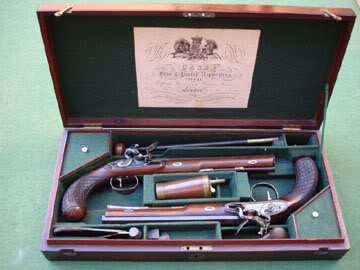
These are pistols by Wogdon from the 1780s. They have hair or set triggers but no adjustment screw is visible because it was done by an internal screw set by the gunsmith. Unlike the Italian "Moore" pistols, note that on British guns, the barrel keys always go in from the side opposite the lock, always. Someone put the keys in backwards on the upper pistol. Also note the front and rear sights, which was typical.
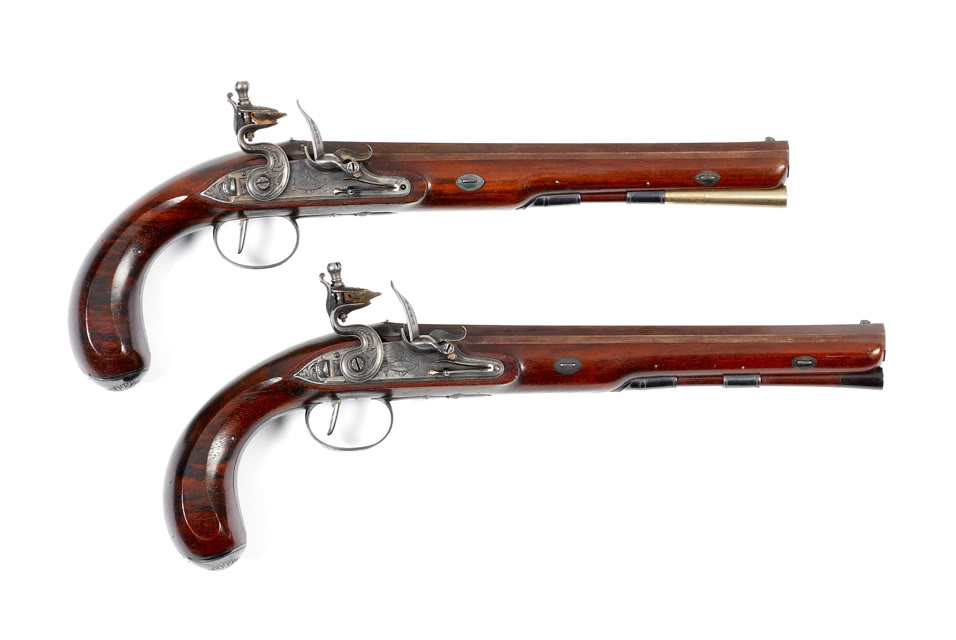
Wogdon built the pistols used in the Hamilton-Burr duel, however they were later modified by some other gunsmith. The hair triggers on them were not secret but a well understood normal feature on British duelers. Below is a cased set I made modeled after an original pair of Wogdons, which I examined years ago.
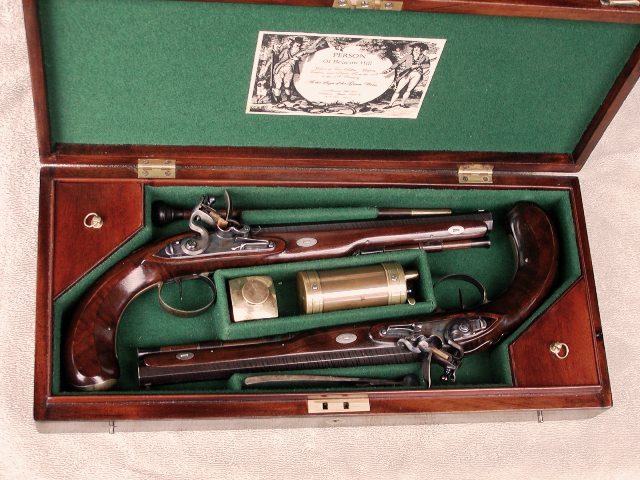
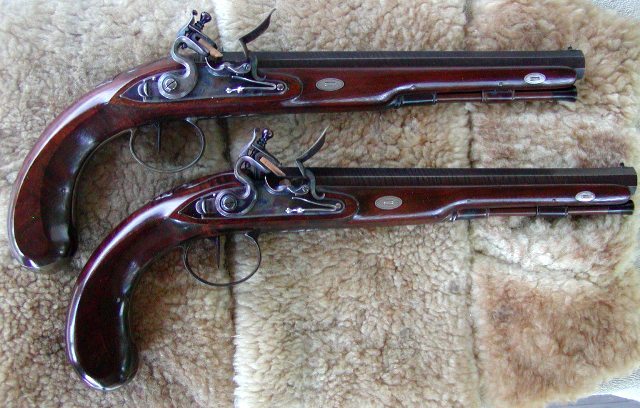
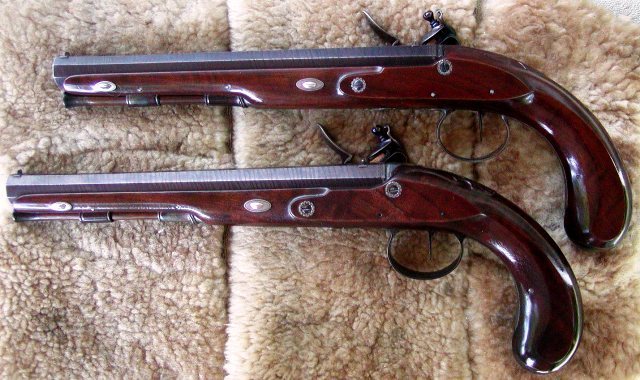
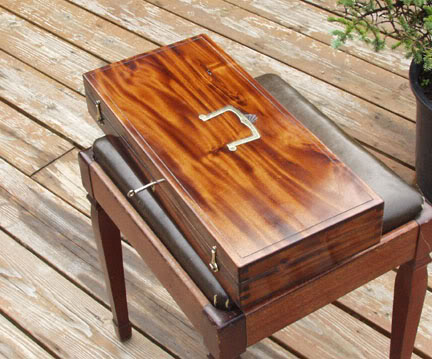
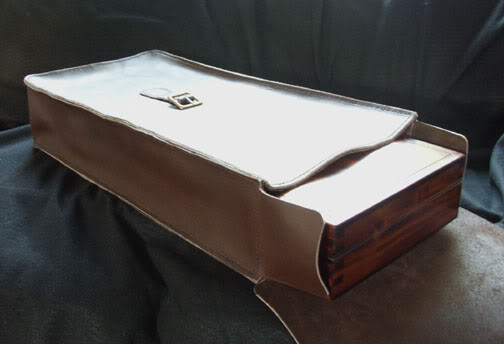
Making a correct modern pair is difficult because no one makes the right locks. I built mine from cast parts by E. J. Blackley in the UK, which copied an original Wogdon lock. No one makes correct trigger guards either, so I had to weld mine. The case is historically correct based on examination of originals and includes the correct wool baize fabric lining. These pistols and case represent Wodgon's style during the late 1780s, By 1800, barrels were heavier and half stocks became the fashion. The pistols may have been more accurate but they lost the lighter, balance, and feel of the earlier pistols. These pistols and case would sell for at least $4000. Keep in mind, original British duelers often cost 20 pounds at a time when a family could live comfortably on 50 pounds annually.
dave
A lot will depend on how historically accurate you want to be. The first step is good research. There is a lot of wrong information spread on the internet about dueling pistols, particularly British ones. The fully evolved British dueling pistol by 1780 had fully octagonal barrels, mostly smooth bored, although a few had shallow scratch rifling, most often set or hair triggers, front and rear sights, plain full or half stocks, little ornamentation except engraving, locks of the highest quality and perfect workmanship. The Pedersoli Charles Moore pistols are about as close as you will find to real British duelers but it falls short on historical accuracy and quality compared with those originals. It is an early 19th century style. Go to www.flintlockcollection.com and view "Best of the Best" and "Cased Pistols". Geoff Walker shows many classic dueling pistols and it is a good place to begin educating yourself about them. John Atkinson's book "The British Dueling Pistol" is also a good place to begin. Cases are another subject altogether. I rarely see any modern made attempts that are correct. Most have compartments that remind me more of TV dinner trays rather than real pistols cases. Usually the hinges, wood, lining, latches, and partitions are all wrong. Cases were not for display, they were for traveling with your pistols and as such, the guns fit snugly and securely within the case. Usually a case came with a stout leather cover to protect it. Below is a photo of original pistols in their case by Barton who previously was a partner with Robert Wogdon. These represent pistols from the late 1780s-1800. Styles changed over time.

These are pistols by Wogdon from the 1780s. They have hair or set triggers but no adjustment screw is visible because it was done by an internal screw set by the gunsmith. Unlike the Italian "Moore" pistols, note that on British guns, the barrel keys always go in from the side opposite the lock, always. Someone put the keys in backwards on the upper pistol. Also note the front and rear sights, which was typical.

Wogdon built the pistols used in the Hamilton-Burr duel, however they were later modified by some other gunsmith. The hair triggers on them were not secret but a well understood normal feature on British duelers. Below is a cased set I made modeled after an original pair of Wogdons, which I examined years ago.





Making a correct modern pair is difficult because no one makes the right locks. I built mine from cast parts by E. J. Blackley in the UK, which copied an original Wogdon lock. No one makes correct trigger guards either, so I had to weld mine. The case is historically correct based on examination of originals and includes the correct wool baize fabric lining. These pistols and case represent Wodgon's style during the late 1780s, By 1800, barrels were heavier and half stocks became the fashion. The pistols may have been more accurate but they lost the lighter, balance, and feel of the earlier pistols. These pistols and case would sell for at least $4000. Keep in mind, original British duelers often cost 20 pounds at a time when a family could live comfortably on 50 pounds annually.
dave
Last edited:
Ranger 1755
32 Cal
- Joined
- Aug 16, 2020
- Messages
- 41
- Reaction score
- 64
Hi Dave, would like to contact you regarding the 1760 Light Infantry Fusil
what were there weapons, flint or percussion? and any idea what caliber?Rather than duelers, think about a cased pair of pistols. Having a cased pair will open up your possibilities to several varieties of rifles pistols.
Dueling pistols were supposed (in England at least, France did not have the defined pattern for pistols) to be smoothbore and no rear sights. They would have had a simple trigger. I know, the Hamilton duelers had a single set trigger that was not disclosed to the seconds or to Aaron Burr.
I've been doing research on this for a while now, here and there. I knew when I decided to do this there would have to be some compromises made on authenticity, but I want to get as close as I can to a "shootable" set as I can.
- Joined
- Nov 26, 2005
- Messages
- 5,023
- Reaction score
- 9,985
Hi,
Toot, I guess your question is an opportunity to clear up a lot internet misinformation about these and other British dueling pistols.
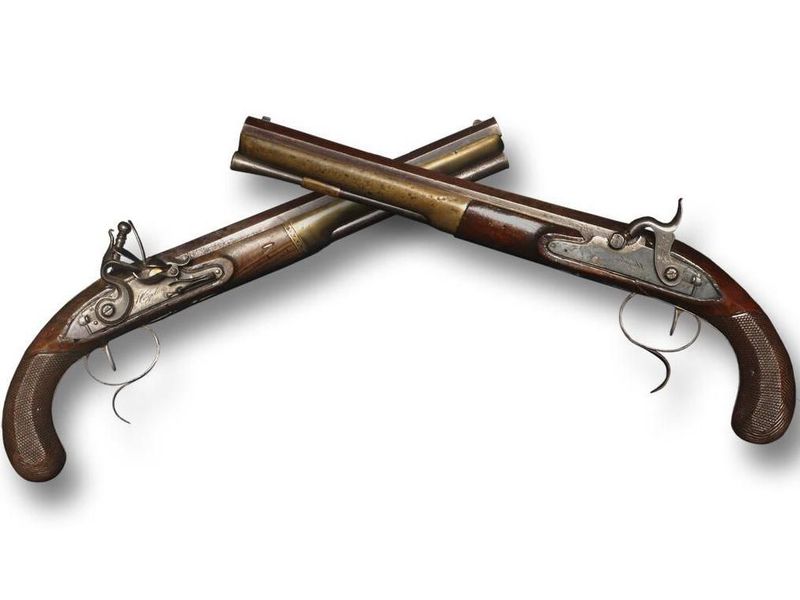
They were both flintlocks at the time of the duel and made by Robert Wogdon of London. The picture shows one was later converted much later after the duel to percussion. Also note the photo of percussion gun was reversed in the image. Both guns had locks on the same right side. When originally made, these pistols were stocked to the muzzle in wood and had standard hair triggers adjusted by a gunsmith. They were made during the late 1780s or early 1790s. During their useful life, the forestocks were removed and replaced by heavy brass. This was done to make them more muzzle heavy, which reduced the risk of a nervous dueler shooting high. Wogdon actually curved the bores of his barrels downward to correct that problem. This was verified by radiography in Stewart and Bailey's recent book on Wogdon. Unfortunately, physics ruled the idea did not work. The ramrods are replacements. One of the original rods likely had a removable brass powder measure as a tip. This was unscrewed from the rod, reversed, and then screwed back on for loading. The measure was filled with powder, positioned upright, and the pistol was inverted muzzle down over it. It was slid all the way to the breech and then turned muzzle up so all the powder was delivered to the breech directly and none stuck to the barrel walls. The story that the pistols had secret unknown and scandalous set triggers is rubbish. Hair triggers were the norm on fully evolved British dueling pistols. Both Burr and Hamilton had fought duels previously and it is unlikely they were unfamiliar with hair triggers. Dr. Hossack, a physician that accompanied Hamilton was told by the mortally wounded man, and I quote from Hossack's description: " take care of that pistol; it is undischarged, and still cocked; it may go off and do harm. Pendleton knows that I did not intend to fire at him."
dave
Toot, I guess your question is an opportunity to clear up a lot internet misinformation about these and other British dueling pistols.

They were both flintlocks at the time of the duel and made by Robert Wogdon of London. The picture shows one was later converted much later after the duel to percussion. Also note the photo of percussion gun was reversed in the image. Both guns had locks on the same right side. When originally made, these pistols were stocked to the muzzle in wood and had standard hair triggers adjusted by a gunsmith. They were made during the late 1780s or early 1790s. During their useful life, the forestocks were removed and replaced by heavy brass. This was done to make them more muzzle heavy, which reduced the risk of a nervous dueler shooting high. Wogdon actually curved the bores of his barrels downward to correct that problem. This was verified by radiography in Stewart and Bailey's recent book on Wogdon. Unfortunately, physics ruled the idea did not work. The ramrods are replacements. One of the original rods likely had a removable brass powder measure as a tip. This was unscrewed from the rod, reversed, and then screwed back on for loading. The measure was filled with powder, positioned upright, and the pistol was inverted muzzle down over it. It was slid all the way to the breech and then turned muzzle up so all the powder was delivered to the breech directly and none stuck to the barrel walls. The story that the pistols had secret unknown and scandalous set triggers is rubbish. Hair triggers were the norm on fully evolved British dueling pistols. Both Burr and Hamilton had fought duels previously and it is unlikely they were unfamiliar with hair triggers. Dr. Hossack, a physician that accompanied Hamilton was told by the mortally wounded man, and I quote from Hossack's description: " take care of that pistol; it is undischarged, and still cocked; it may go off and do harm. Pendleton knows that I did not intend to fire at him."
dave
Last edited:
- Joined
- Nov 26, 2005
- Messages
- 5,023
- Reaction score
- 9,985
Hi,I've been doing research on this for a while now, here and there. I knew when I decided to do this there would have to be some compromises made on authenticity, but I want to get as close as I can to a "shootable" set as I can.
Great! Do the research so you understand your quarry. Just be careful using the internet because much of the information posted on British and other duelers and dueling is rubbish. Atkinson's book is very good as an introduction. Another key published reference is Keith Neal and David Back's "Great British Gunmakers 1740-1790: the History of John Twigg and the Packington Guns". It is expensive and rare but there are many libraries with copies. It discusses many guns but focuses on John Twigg who may be considered one of the fathers of the true British dueling pistol. The ultimate reference is a recent (2019) book by John O'Sullivan and DeWitt Bailey titled "Richard Wogdon, Wogdon and Barton, John Barton: London Gunmakers 1764-1819" published by Bonham's auction house. It contains a wealth of detail on dueling pistols and dueling and includes detailed color photos of most of Wogdon's surviving pistols. Unfortunately, I may have the last copy offered for general purchase and the rest are to be sold at Bonham's fall auction. You may be able to secure a copy if you contact them directly. Below are links to a 5-part tutorial I posted on building a correct British case for pistols. As far as I know, it is the only source of accurate information on that topic you will find on the internet.
https://americanlongrifles.org/forum/index.php?topic=5339.0https://americanlongrifles.org/forum/index.php?topic=5359.0https://americanlongrifles.org/forum/index.php?topic=5369.0https://americanlongrifles.org/forum/index.php?topic=6416.0https://americanlongrifles.org/forum/index.php?topic=6417.0Look at them all and read them carefully. They contain a wealth of information you will not find anywhere else.
dave
- Joined
- Nov 26, 2005
- Messages
- 5,023
- Reaction score
- 9,985
Hi,
Peter Dyson has many reproduction trade labels for sale but I'm afraid no labels for Wogdon or Wogdon & Barton. I am not sure anyone has those.
dave
Peter Dyson has many reproduction trade labels for sale but I'm afraid no labels for Wogdon or Wogdon & Barton. I am not sure anyone has those.
dave
- Joined
- Aug 6, 2005
- Messages
- 6,758
- Reaction score
- 4,935
A teabag is your friend when 'aging' the label. You didn't get that from me, capisce?
- Joined
- Nov 26, 2005
- Messages
- 5,023
- Reaction score
- 9,985
Hi,
I found a good quality photo of an original label in a book. I scanned it, then erased the text in the big open white area using photoshop and inserted my own. I printed it out on high quality parchment paper. At some point I will design and draw my own label.
dave
I found a good quality photo of an original label in a book. I scanned it, then erased the text in the big open white area using photoshop and inserted my own. I printed it out on high quality parchment paper. At some point I will design and draw my own label.
dave
Similar threads
- Locked
- Replies
- 14
- Views
- 2K
- Replies
- 24
- Views
- 1K
- Replies
- 10
- Views
- 664





